
Draco is a genus of agamid lizards that are also known as flying lizards, flying dragons or gliding lizards. These lizards are capable of gliding flight; their ribs and their connecting membrane may be extended to create "wings" (patagia), the hindlimbs are flattened and wing-like in cross-section, and a flap on the neck serves as a horizontal stabilizer and are sometimes used in warning to others. Draco are arboreal insectivores.
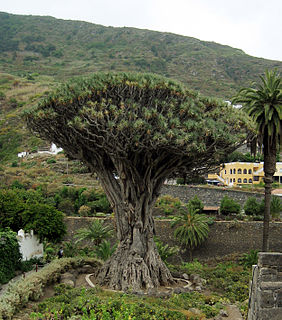
Dracaena draco, the Canary Islands dragon tree or drago, is a subtropical tree in the genus Dracaena, native to the Canary Islands, Cape Verde, Madeira, western Morocco, and is thought to be introduced in the Azores. It is the natural symbol of the island of Tenerife, together with the blue chaffinch. Its closest living relative is the dragon's blood tree of Socotra, Dracaena cinnabari.
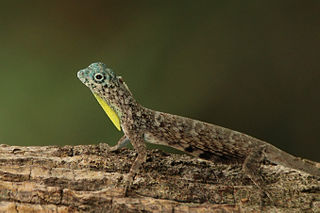
Draco volans, also commonly known as the common flying dragon, is a species of lizard in the family Agamidae. The species is endemic to Southeast Asia. Like other members of genus Draco, this species has the ability to glide using winglike lateral extensions of skin called patagia.

Draco blanfordii, commonly known as Blanford's flying dragon, Blandford’s flying lizard, or Blanford's gliding lizard, is a species of "flying" lizard in the family Agamidae. The species is endemic to Asia, and is capable of gliding from tree to tree.

Draco dussumieri or Indian flying lizard, is a species of agamid lizard capable of gliding from tree to tree. It is found principally in the Western Ghats and some other hill forests of Southern India. They are almost completely arboreal, found on trees in forests and adjoining palm plantations where they climb trees to forage for insects and glide to adjoining trees by expanding the patagium, loose skin on the sides of the body which are supported by elongated ribs to act as wings. The skin on the sides of the neck are also extended to the sides using the hyoid bones of the tongue to support them. During the breeding season males maintain small territories which they defend from other males while courting females. Males have a more colourful patagium than females and they prominently extend their yellow dewlaps forward in display. Although living almost their entire lives on the trees, females descend to the ground to lay eggs in soil. This is the species with the westernmost distribution within the genus Draco, the majority of species occurring in Southeast Asia.
The reticulated toad-headed agama is a species of agamid lizard found in Central Asia and West Asia.
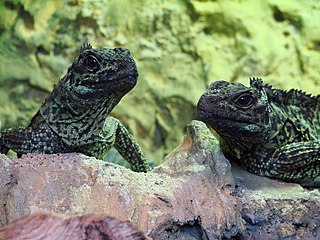
The Amboina sail-finned lizard or Amboina sailfin lizard is the largest agamid lizard in the world, growing to over one metre (3.3 ft) in length. It is found in wooded habitats near water in New Guinea and Ambon/Amboina Island (Indonesia). Although it has been reported from the Philippines and Sulawesi, a genetic study have shown that all in the former country are Philippine sailfin lizards H. pustulatus, while genetic and morphological studies have shown that individuals from the latter island belong to two separate species to which the names H. celebensis and H. microlophus are available. Adult male Amboina sail-finned lizards have outer edges of the eyes that are medium-dark clear blue and no nose crest, which are some of the features that separate them from the Sulawesi species.
Platymantis bimaculatus is a species of frog in the family Ceratobatrachidae. It is endemic to West Papua, Indonesia.
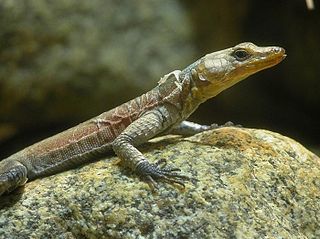
The Pungwe flat lizard is a species of lizard in the Cordylidae family.
Draco indochinensis, also known as the Indochinese flying lizard or Indochinese gliding lizard, is a species of agamid lizard endemic to South-east Asia.

Anolis bimaculatus, the panther anole, also known as the St. Eustatius anole, is a species of anole lizard that is endemic to the Caribbean Lesser Antilles. It is found on the St. Kitts Bank of islands, which comprise Saint Kitts, Nevis, and Sint Eustatius.
The black-spotted ridge-tailed monitor, also called commonly the black-spotted spiny-tailed monitor, the lemon-throated monitor, the northern ridge-tailed monitor, Whites monitor, and the yellow-throated monitor, is a species of lizard in the family Varanidae. The species is native to Australia's tropical Northern Territory. It is listed as Least Concern on the IUCN Red List as it is considered common and not threatened. It was first described in 1987. It is also known as White's dwarf goanna.
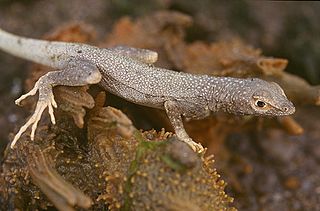
Microlophus theresiae, commonly called Theresia's Pacific iguana, is a species of lizard in the family Tropiduridae.
Lepidonectes bimaculatus, known commonly as the twinspot triplefin, is a species of triplefin blenny in the genus Lepidonectes. It was described by Gerald R. Allen and David Ross Robertson in 1992. This species is found in the eastern Pacific Ocean where it has been recorded only in the vicinity of Malpelo Island in Colombia. The twinspot triplefin acts as a cleaner fish, its only client species being the grouper Epinephelus labriformis.

Draco mindanensis, commonly known as the Mindanao flying dragon, is a lizard species endemic to the Philippines. Characterized by a dull grayish brown body color and a vivid tangerine orange dewlap, this species is one of the largest of the genus Draco. It is diurnal, arboreal, and capable of gliding.

Ompok bimaculatus, known as butter catfish, is a species of sheatfishes native to Asian countries such as Bangladesh, India, Pakistan, and Sri Lanka, but recently identified in Myanmar.

Draco cornutus is a species of "flying dragon", an agamid lizard. It is endemic to Borneo. It occurs at elevations up to 700 m (2,300 ft) above sea level, although its distribution is poorly known.
Cordylus rivae, the Ethiopian girdled lizard, is a species of lizard in the family Cordylidae. It is a small, spiny lizard found in Ethiopia.
Platysaurus attenboroughi is a species of lizard in the family Cordylidae. It is a small, spiny lizard found in Namibia.
Smaug barbertonensis is a species of lizard in the family Cordylidae. It is a small lizard found in eastern South Africa and Eswatini.












